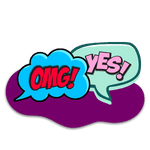|
By Brydie Wright
Have you ever found yourself watching a black comedy on the stage or screen and thought, why am I laughing at this? What does this say about my sense of humour? I’d say you were normal. There are many types of comedy and we often laugh to deal with discomfort, shock or moral dubiousness. Think Seinfeld. |
|
It's no different in children's literature. The industry is moving away from saccharine sweet, to an appreciation for realism and humour that doesn't underestimate children's intelligence. Last month on The Blogfish, I talked about light-hearted humour in picture books and this time, I’d like to discuss the flipside: - dark humour.
|
Earlier this year, I attended a FREE webinar hosted by the Children's Book Academy. Dr Mira Reisberg invited Editor, Julia Maguire, to share tips on what makes a great narrative, in the style of dark humour. The books that succeed with black humour often share some, if not all, these characteristics. They: -
- break with traditional narrative structure
- engage parents, with levels of irony
- have ‘bite’
- use animal characters to help soften any elements of moral dubiousness
- employ a deadpan tone, with simple jokes and a simple premise
- incorporate playful asides, letting the reader 'in on' a character’s motivations
- put forward an absurd or OTT (over the top) scenario, using hyperbole
- craft short, straightforward text, with elements of sour balancing out the sweet
- convey humour through illustrative style.
A clear example of the classic use of dark humour, in a picture book, is Zombie in Love by Kelly DiPucchio and Scott Campbell. It takes an icon of the horror genre and places him in a hapless romance narrative. Through use of an OTT scenario and ‘woe is me’-exclamations, the zombie becomes a figure of sympathy. The reader is invited to both laugh and cry, with this lonely figure who just wants to find love.
Recently, Bryan Avery wrote in The Blogfish about Jon Klassen’s modern classic, I Want My Hat Back I’d like to expand on a discussion of this author, by describing him as a master of subtle dark humour. His characters deal with everyday moral quandaries that kids can relate to, like ‘outing’ the person who has stolen your hat, or in the case of my personal favourite, We Found a Hat, deciding whether to sell out your best friend and take something you both want.
Klassen is not advocating the triumph of revenge or dishonesty but he is acknowledging that they are real human emotions and he plays mischievously with the concepts, delighting children with the suggestion of naughtiness. Klassen’s humour goes by the style of simplicity, narrating through dialogue and letting his illustrations and their dark colour palette, do most of the talking. And, he uses animal characters to engage young readers and soften the blow of potentially questionable but relatable human behaviour.
Recently, it was a revelation to come across the work of new Australian author-on-the-rise, Philip Bunting. His narrative and illustrative style has been likened to Jon Klassen's and I agree with this comparison. Mopoke is Bunting’s innovative, break out hit for 2017. When I first glanced through the book, I’ll admit I didn’t exactly laugh out loud but I read it to my 5-year old son. With no prompting at all from me, he belly-laughed his way through every darkly-illustrated page. Like the sparse text used by Klassen, Bunting keeps it incredibly simple. The premise is a naturally quiet, little mopoke (a type of owl) who becomes a figure of fun through visual humour.
The narrative pattern is word play. Each spread has a full page illustration accompanied by a play on words. For example, ‘High-poke’, with a figure of a mopoke in a top hat. “Low-poke’, with a graphic of a mopoke down on his luck, and ‘Mow-poke’ to describe a mopoke with a moustache. The dark quality of the humour is heightened through the colour scheme, which favours blacks and browns. It is also conveyed via deadpan humour; quite opposite to the exaggerated comedy of Zombie in Love, and more akin to Klassen.
Next time you laugh at a book, particularly a children’s book, stop and think about what makes it funny? Julia Maguire and Mira Reisberg opened a world of the different genres of humour to me. I am keen to try them all as a writer. Next month in my blog post, I am feeling inspired to write about fractured fairy tales, a popular genre that often takes its cue from dark humour.
What are your favourite picture books that use black humour? I’d love your suggestions in the comments!
Brydie Wright Bio
Graduate, Craft & Business of Children’s Picture Book Writing Course
Chief Editor, Sydney Mums Group and Reviewer, WeekendNotes
Author of Daddy and the World's Longest Poo, IAN Awards 2017 Finalist, & Magic Beans from the Creative Kids Tales Story Collection
Website - Facebook - Twitter - Goodreads
The narrative pattern is word play. Each spread has a full page illustration accompanied by a play on words. For example, ‘High-poke’, with a figure of a mopoke in a top hat. “Low-poke’, with a graphic of a mopoke down on his luck, and ‘Mow-poke’ to describe a mopoke with a moustache. The dark quality of the humour is heightened through the colour scheme, which favours blacks and browns. It is also conveyed via deadpan humour; quite opposite to the exaggerated comedy of Zombie in Love, and more akin to Klassen.
Next time you laugh at a book, particularly a children’s book, stop and think about what makes it funny? Julia Maguire and Mira Reisberg opened a world of the different genres of humour to me. I am keen to try them all as a writer. Next month in my blog post, I am feeling inspired to write about fractured fairy tales, a popular genre that often takes its cue from dark humour.
What are your favourite picture books that use black humour? I’d love your suggestions in the comments!
Brydie Wright Bio
Graduate, Craft & Business of Children’s Picture Book Writing Course
Chief Editor, Sydney Mums Group and Reviewer, WeekendNotes
Author of Daddy and the World's Longest Poo, IAN Awards 2017 Finalist, & Magic Beans from the Creative Kids Tales Story Collection
Website - Facebook - Twitter - Goodreads











